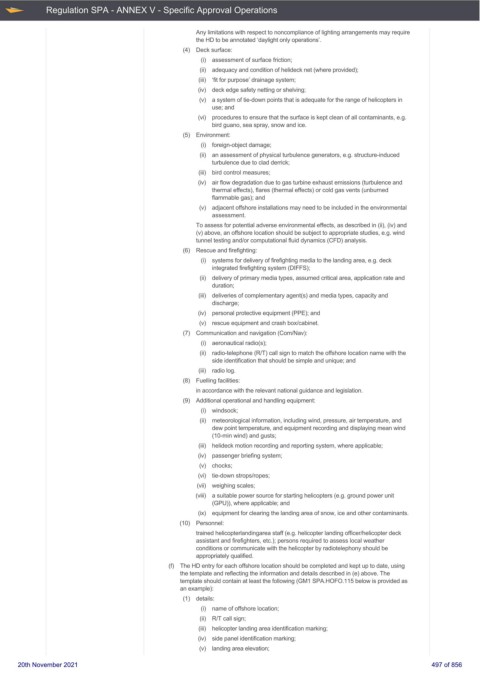Page 497 - UK Air Operations Regulations 201121
P. 497
~
~ Regulation SPA - ANNEX V - Specific Approval Operations Centrik
Any limitations with respect to noncompliance of lighting arrangements may require
the HD to be annotated ‘daylight only operations’.
(4) Deck surface:
(i) assessment of surface friction;
(ii) adequacy and condition of helideck net (where provided);
(iii) ‘fit for purpose’ drainage system;
(iv) deck edge safety netting or shelving;
(v) a system of tie-down points that is adequate for the range of helicopters in
use; and
(vi) procedures to ensure that the surface is kept clean of all contaminants, e.g.
bird guano, sea spray, snow and ice.
(5) Environment:
(i) foreign-object damage;
(ii) an assessment of physical turbulence generators, e.g. structure-induced
turbulence due to clad derrick;
(iii) bird control measures;
(iv) air flow degradation due to gas turbine exhaust emissions (turbulence and
thermal effects), flares (thermal effects) or cold gas vents (unburned
flammable gas); and
(v) adjacent offshore installations may need to be included in the environmental
assessment.
To assess for potential adverse environmental effects, as described in (ii), (iv) and
(v) above, an offshore location should be subject to appropriate studies, e.g. wind
tunnel testing and/or computational fluid dynamics (CFD) analysis.
(6) Rescue and firefighting:
(i) systems for delivery of firefighting media to the landing area, e.g. deck
integrated firefighting system (DIFFS);
(ii) delivery of primary media types, assumed critical area, application rate and
duration;
(iii) deliveries of complementary agent(s) and media types, capacity and
discharge;
(iv) personal protective equipment (PPE); and
(v) rescue equipment and crash box/cabinet.
(7) Communication and navigation (Com/Nav):
(i) aeronautical radio(s);
(ii) radio-telephone (R/T) call sign to match the offshore location name with the
side identification that should be simple and unique; and
(iii) radio log.
(8) Fuelling facilities:
in accordance with the relevant national guidance and legislation.
(9) Additional operational and handling equipment:
(i) windsock;
(ii) meteorological information, including wind, pressure, air temperature, and
dew point temperature, and equipment recording and displaying mean wind
(10-min wind) and gusts;
(iii) helideck motion recording and reporting system, where applicable;
(iv) passenger briefing system;
(v) chocks;
(vi) tie-down strops/ropes;
(vii) weighing scales;
(viii) a suitable power source for starting helicopters (e.g. ground power unit
(GPU)), where applicable; and
(ix) equipment for clearing the landing area of snow, ice and other contaminants.
(10) Personnel:
trained helicopterlandingarea staff (e.g. helicopter landing officer/helicopter deck
assistant and firefighters, etc.); persons required to assess local weather
conditions or communicate with the helicopter by radiotelephony should be
appropriately qualified.
(f) The HD entry for each offshore location should be completed and kept up to date, using
the template and reflecting the information and details described in (e) above. The
template should contain at least the following (GM1 SPA.HOFO.115 below is provided as
an example):
(1) details:
(i) name of offshore location;
(ii) R/T call sign;
(iii) helicopter landing area identification marking;
(iv) side panel identification marking;
(v) landing area elevation;
20th November 2021 497 of 856

